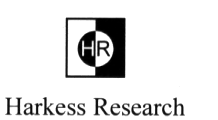
 Wisp
Unification Theory - 9 Wisp & Special Relativity: Doppler Effect
Wisp
Unification Theory - 9 Wisp & Special Relativity: Doppler Effect
- Home
- About Me
- Reasons why Einstein was wrong
- One-way speed of light experiments
- Hot topic
- Q&A
- ACES - The end of Relativity
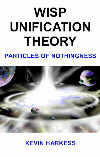
- Book Contents
- Introduction
- 1 Matter,Space and Time
- 2 Symmetry
- 3 Fractals
- 4 Wisp Space
- 5 Gravity
- 6 Electromagnetic Force
- 7 Wisp & S.R: Fundamentals
- 8 Wisp & S.R: Electrodynamics
- 9 Wisp & S.R: Doppler effect
- 10 Wisp & S.R: Relativistic Mechanics
- 11 Big bang
- Appendix A
- Appendix B
- Index A-Z
- Copyright
- Feedback
This page contains the complete chapter. To download the new 2011 2nd edition of wisp unification theory go to the homepage.
9
Wisp and Special Relativity: Doppler Effect
9.1 The Doppler effect of light
The Doppler effect of light occurs when an observer moves relative to
a light source, causing an increase or decrease – Doppler shift –
in the frequency observed.
Special relativity appears to predict the correct Doppler effect in all
cases, and this is one of its most common applications.
Scientist believe that the presence of an ether medium would cause Doppler
effects that would be different to those predicted by special relativity.
For example, the Doppler equations for sound and water waves – which
both propagate in mediums – are completely different to those of
light. So one could assume that light does not propagate in a medium,
as is the case with special relativity.
However, wisp theory attributes the Doppler effect of light to motion
through an absolute ether medium – wisp space, and so differs dramatically
from special relativity.
The frequency predictions of wisp theory and special relativity agree
almost exactly in every detail except one – a predicted increase
in frequency as opposed to a decrease for a moving observer’s transverse
Doppler shift.
We will examine Doppler effect case by case and make comparisons with
special relativity’s predictions. And we use the results obtained
to develop a single general Doppler equation for wisp theory.
We will find that if we limit an observer’s motion through absolute
wisp space to zero then the equation reduces to that of special relativity’s.
9.1.1 Light source device
A stationary electronic device emits light, which travels at speed c through
one-state space. It has wavelength (lambda o), and frequency fo.
The period (delta T) of the electrical oscillations within the
device determines the frequency of the light emitted.
When the device moves through wisp space, time dilation affects its period
of oscillation, increasing it by (gamma), which in turn reduces
the frequency of the light emitted.
9.2 Doppler effect
9.2.1 Doppler effect: transverse observer motion
We apply wisp’s principles to determine the Doppler effect for an
observer moving at right angles to a wide stationary light source (Figure
9.1).
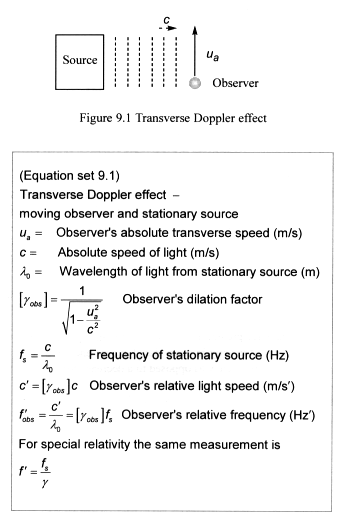
The wavelength of light emitted from the source has the same length in
all reference frames – length invariance. And an observer measures
the frequency of light by dividing its relative speed by its wavelength.
The observer is moving at right angles to light’s motion, and so
no relative displacement takes place in the direction of light, and light’s
relative speed (measured in absolute time) remains at c. But the moving
observer experiences time dilation, and so we apply the rules for time
dilation compensation (Section 7.15.4). This increases the observer’s
relative speed of light by gamma, which results in an observed increase
in frequency.
The value predicted for the observed relative frequency is greater than
that of the source (Equation set 9.1).
Wisp theory and special relativity agree on the size of the frequency
change, but disagree on its sign. Wisp theory predicts a positive value,
whereas special relativity predicts a negative value.
9.2.2 Doppler effect: transverse source motion
A wide light source moves at right angles to a stationary observer (Figure
9.2).
In this case wisp theory predicts a decrease in frequency, which is the
same as that predicted by special relativity (Equation set 9.2).
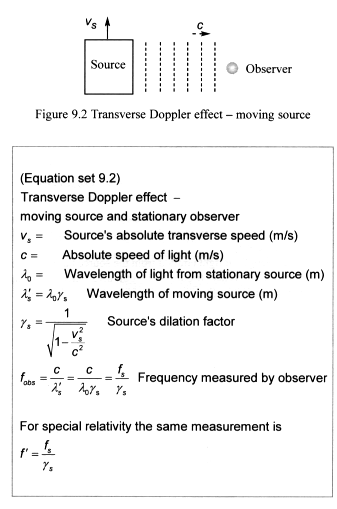
9.2.3 Transverse Doppler effect experiments
Experiments to measure the frequency radiated from high-speed atoms have
been carried out to test for Doppler effect. The results show a decrease
in observed frequency in the transverse direction, in agreement with both
wisp theory and special relativity’s predictions.
In 1963 Walter Kundig carried out an experiment on transverse Doppler
shift. He used a rotating turntable with a radiation source placed at
its centre and an absorber placed on its rim. The relative motion of the
source and absorber are transverse at all times, and so the change in
frequency detected will be due solely to time dilation.
Although the results of the experiment agree with special relativity to
within 1 percent, we can only say with certainty that a frequency change
took place due to the effect of time dilation. We cannot say whether the
change was positive or negative.
Wisp theory predicts a positive change in frequency, whereas special relativity
predicts a negative change. Both predicted changes have the same magnitude
and will therefore have the same effect on the absorber. The results of
the experiment are therefore inconclusive.
9.2.4 Testing a moving observer’s transverse Doppler effect
A receiver placed in a polar satellite could be used to detect a small
positive increase in radio frequency due to the transverse Doppler effect.
It is important that the receiver moves faster through wisp space than
the frequency source. The change in frequency measured will be a few parts
per billion. The satellite’s position and time measurements must
be accurately recorded, as the frequency changes associated with approaching
and receding Doppler effects could swamp the readings. Test instruments
would need to be extremely accurate and sensitive.
Appendix A shows detailed results predicted by wisp theory, which differ
slightly to those predicted by special relativity.
9.2.5 Doppler effect: observer receding from a stationary source
An observer moves away from a stationary light source at absolute speed
ua as shown in Figure 9.3. The observer’s
relative speed of light decreases and the rules for time dilation compensation
(Section 7.15.4) are applied.
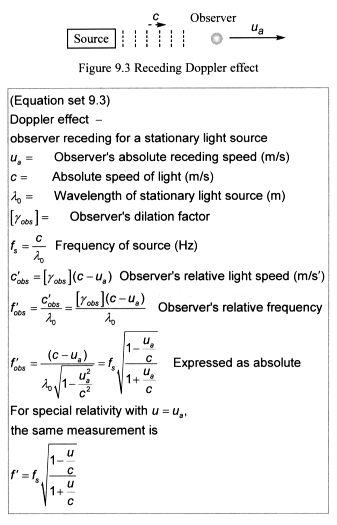
Equation set 9.3 gives the result for wisp theory. Although derived in
a manner different from special relativity’s, simple manipulation
of the final equation shows that it is identical to Einstein’s Doppler
equation.
We have assumed that the light source is stationary in wisp space, and
derived the result accordingly. However, we will find later that when
the source moves through wisp space the result will be the same as for
when it was stationary.
Also we will discover that if both source and observer were in motion
through wisp space, the result again will be the same as if the source
or observer were stationary.
9.2.6 Doppler effect: observer approaching a stationary source
An observer moves towards a stationary light source at absolute speed
ua (Figure 9.4).
The moving observer is subject to the effect of time dilation, which causes
the relative speed of light to increase – see the rules for time
dilation compensation (Section 7.15.4).
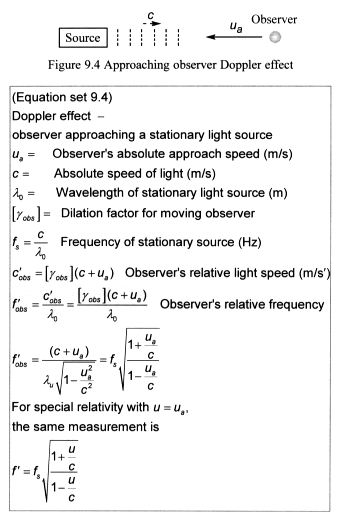
Equation set 9.4 shows the frequency recorded by the observer. Once again
simple manipulation of the final equation shows that it matches the prediction
of special relativity.
9.2.7 Doppler effect: source moving and observer stationary
A source moves towards a stationary observer at speed vs
(Figure 9.5).

The observer measures no increase in lights speed – see section 7.2.2
(Wisp relativity’s principle 2 – absolute speeds are constant).
Time dilation affects the moving source, increasing its relative time
period, which in turn increases the wavelength of its emitted light. Also
during the time interval (delta T’) the source moves towards
the emitted wave crest, and releases the next wave closer to the previous
one (Figure 9.6), thereby reducing the wavelength of light moving through
wisp space.
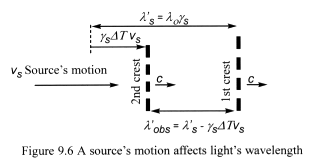
The stationary observer is unaffected by time dilation and records the
received frequency as the absolute speed of light divided by the wavelength
(Equation set 9.5).
When the source passes the stationary observer – moving away, we
change the speed vs to -vs,
and use the same formula.
The Doppler effect results are identical to those predicted by special
relativity.
9.3 Doppler effect – general motion : observer and source moving
An observer and light source move through wisp space at absolute speeds
ua and vs
respectively (Figure 9.7).
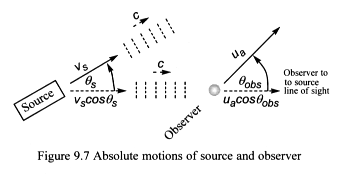
The observer’s relative speed of light increases or decreases, depending
on the values of the variables selected.
The absolute speed values chosen for the source and observer can be positive
or negative, but they must not exceed the absolute speed of light c.
If we consider the distance between source and observer to be large, then
their motions will not affect the angles (theta s)
and (theta obs) that they make with the
line of sight joining their centres.
We simply input the angle and absolute speed values into Equation set
9.6 to calculate the Doppler effect.
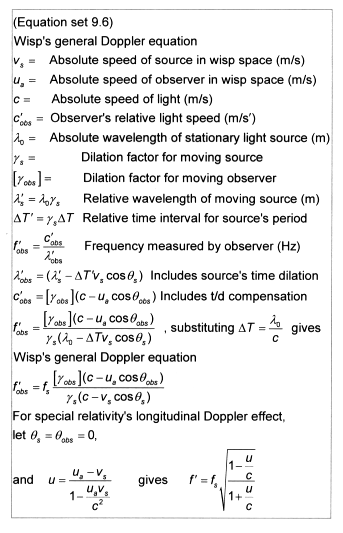
The maximum absolute speed between a source and an observer is twice the
speed of light.
If an observer approaches a stationary source at near light speed, the
observer will see the source ‘approach’ at a speed greater than
that of light. This is an illusion effect caused by time dilation.
Equation set 9.7 shows wisp’s general Doppler equation. Although
derived using concepts different to special relativity’s, simple
manipulation using a limit process shows that it is identical to special
relativity’s Doppler equation.
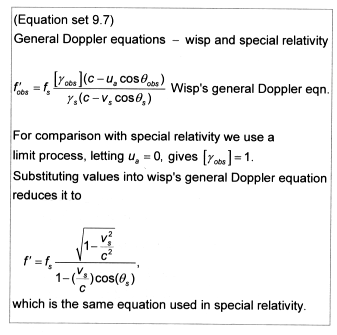
Wisp’s general Doppler equation calculates the Doppler effect for
all observer–source motions through wisp space.
It agrees with special relativity’s predictions in all cases except
one – see sections 9.2.1 (Doppler effect: transverse observer motion);
9.2.4 (Testing a moving observer’s transverse Doppler effect); and
Appendix A.
The main difference between the two equations is that wisp theory allows
for both observer and source to be in separate motions with respect to
an absolute reference frame. So its equation has two absolute speed terms
and two angles. Whereas special relativity is a limiting case where the
observer is at rest in wisp space, and so uses one speed term and one
angle.
If we assume that the Earth moves through wisp space at 30,000 m/s, then
the relativistic effects on its surface are almost zero, practically undetectable.
This explains why special relativity has remained so successful.
However, technology is now available that will allow detection of the
Earth’s relativistic effects caused by its motion through wisp space.
If results are positive, which I believe they will be, then wisp theory
will become a credible alternative to special relativity.
Home --
About Me -- Reasons
why Einstein was wrong -- One-way
speed of light experiments -- Hot
topic -- Q&A -- ACES
- The end of Relativity --
Book Contents -- Introduction
-- 1 Matter,
Space and Time -- 2
Symmetry -- 3
Fractals -- 4 Wisp Space
-- 5 Gravity -- 6
Electromagnetic Force --
7 Wisp & S.R: Fundamentals
-- 8 Wisp & S.R: Electrodynamics
-- 9 Wisp & S.R: Doppler
effect -- 10
Wisp & S.R: Relativistic Mechanics --
11 Big bang -- Appendix
A -- Appendix B -- Index
A-Z -- Copyright -- Feedback